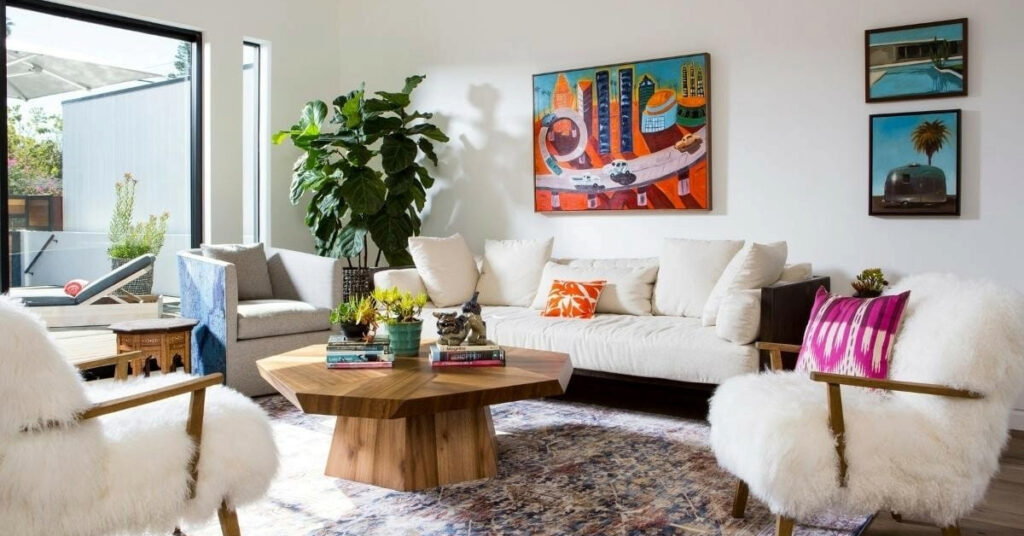Creating a space that accommodates the needs of both adults and children without compromising on aesthetics isn’t too difficult. You just need to maintain a balance between functionality and stylishness.
Prioritise Open Floor Plans
A cornerstone of family-friendly home design is the use of open-floor plans. They create a sense of spaciousness and allow the family to interact with one another. Removing unnecessary walls between the kitchen, dining and living areas not only enhances the flow of natural light, but it also allows you to supervise and communicate better with your children. For example, you can cook and keep an eye on the kids. It also allows family gatherings to become more inclusive and engaging.
Durable and Easy-to-Clean Materials
When designing a family-friendly home, durability and ease of maintenance should be top priorities. You want materials that can withstand the wear and tear of daily life. Vinyl flooring, for instance, isn’t just stylish, it’s also easy to clean and resilient to spills and scratches. For furniture, you’ll want to consider stain-resistant fabrics like microfibre or leather. Area rugs can add warmth and comfort too, but it’s best to go for ones that are easy to clean or have patterns to hide any stains.
Smart Storage Solutions
Clutter is a common issue in family homes. But you can keep it under control with smart storage solutions. Think about built-in storage such as cabinets and shelves, which maximise space and keeps items organised. In your living room, consider multifunctional furniture like ottomans with storage compartments or coffee tables with hidden drawers. For children’s rooms, you should use storage bins and baskets that are accessible for little hands. Labelling these containers can also help children learn to tidy up after themselves.
Child-Safe Design
Safety is paramount in a family-friendly home. Incorporate child-safe features like rounded furniture edges, secure stair gates and outlet covers. Use slip-resistant rugs and avoid any heavy furniture that could tip over. In your kitchen, you should store hazardous items like cleaning supplies and sharp utensils in high or locked cabinets. By following through with these precautions, you not only protect your children, but you also give yourself some peace of mind.
Flexible Spaces
Over time, the needs of your family change and evolve, which is why designing flexible spaces is essential. Think about how a playroom can later be transformed into a home office or study area. You can use modular furniture that can adapt to these changing requirements. For example, bunk beds can be separated into individual beds as children grow older.
Incorporate Personal Touches
It’s crucial to reflect the personalities and interests of your family. You can do this by displaying family photos, children’s artwork and other cherished mementos that create a sense of belonging. Encourage your children to contribute to the décor of their room; whether through selecting paint colours or choosing their bedding. Personal touches make a house feel like a home, fostering a sense of pride and ownership.
Outdoor Living Spaces
Design a garden that caters to all ages with areas for play, dining and lounging. Consider features like a playset and a patio with comfortable seating. Outdoor storage solutions can also help to keep toys and gardening tools organised. A well-designed outdoor space encourages family members to spend time together, enjoying the fresh air and nature. Perfect for family activities and relaxation!
Efficient Use of Technology
Smart home technology can enhance the functionality of your family-friendly home. You can use smart thermostats to maintain a comfortable temperature, while saving energy, Smart lighting systems allow you to control lights remotely and set schedules. You could even include security cameras and smart locks to add an extra layer of safety. Of course, technology can be used for entertainment too, such as streaming devices and wireless speaker for family film nights and music.
Design for All Ages
When designing a family-friendly home, it’s important to consider the needs of all age groups. Create spaces that are accessible and comfortable for everyone – from toddlers to grandparents. In bathrooms, you can install grab bars and non-slip mats. In your kitchen, consider a mix of high and low storage options to accommodate different heights. Don’t forget to ensure that seating is supportive and comfortable too!
Eco-Friendly Choices
Children are expensive. Especially nowadays with the cost-of-living crisis still going strong. By incorporating eco-friendly choices into your home, you can benefit both the environment and your family. Use sustainable materials like bamboo and reclaimed wood flooring. Choose energy-efficient appliances and fixtures to reduce utility bills and environmental impact. You can install water-saving devices such as low-flow faucets and toilets too. An environmentally friendly home also promotes a healthy living space and teaches children the importance of sustainability.
Creating Cosy Nooks
It’s important to remember to have time for yourself amongst the madness of family life. You can create cosy nooks and reading corners that are perfect for quiet moments and individual activities. Designate small spaces with comfortable seating, good lighting and a selection of books or toys. These areas can then provide a retreat for your family members to unwind and enjoy some time alone. Incorporating these spaces throughout your home encourages relaxation and can help reduce any stress.







